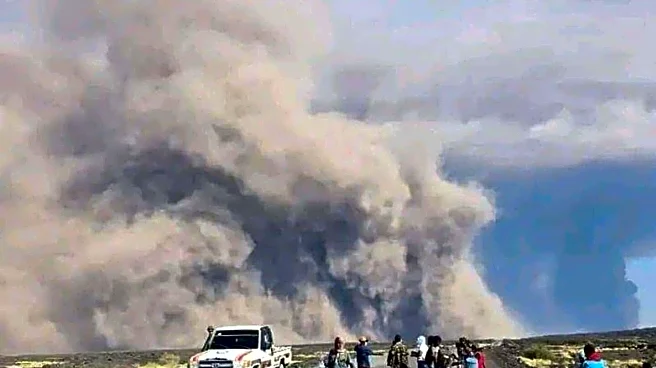A massive ash cloud from Ethiopia’s Hayli Gubbi volcano, which erupted for the first time in nearly 10,000 years, is drifting toward northern India, according to the Toulouse Volcanic Ash Advisory Centre
(VAAC). The eruption began explosively around 8:30 am UTC on Sunday, sending ash high into the atmosphere before subsiding, but the plume continues to move rapidly eastward.
Ash Cloud to Reach Gujarat, North India Tonight
Weather agency IndiaMetSky says the ash plume will enter Gujarat this evening and then spread toward Rajasthan, northwest Maharashtra, Delhi, Haryana, Punjab, and eventually the Himalayas by around 10 pm.
The plume is traveling at 100–120 km/h, at altitudes of 15,000–25,000 feet, and in some areas up to 45,000 feet.
What Is an Ash Cloud?
An ash cloud forms when volcanic eruptions eject fine particles of ash, sulphur dioxide, and microscopic fragments of rock and glass into the atmosphere. These particles can travel thousands of kilometres depending on wind patterns.
These particles can remain suspended in the atmosphere for long periods and travel thousands of kilometres.
Health Hazards You Should Know
Volcanic ash can:
- darken the sky and make it appear hazy
- irritate the eyes, skin, and throat
- worsen asthma, bronchitis, and other respiratory issues
How to Protect Yourself
- Stay indoors during any visible ashfall
- Keep doors and windows closed
- Wear an N95 mask outdoors
- People with respiratory problems should take extra caution and keep medications handy
Meteorologists say residents may notice darker skies, haze, and unusual sunsets as the plume passes.
The Hayli Gubbi Volcano: A Rare Eruption
The Hayli Gubbi volcano, part of Ethiopia’s Erta Ale range, last erupted 10,000–12,000 years ago.
Sunday’s eruption sent ash clouds across the Red Sea toward Oman and Yemen, and the plume has since shifted toward India.
Experts have encouraged people to share photographs of the rare atmospheric event.
Aviation Impact & DGCA Advisory
Volcanic ash poses a serious threat to aircraft, as it can damage engines, reduce visibility, and force flight rerouting. Historic aviation incidents show that planes flying through dense ash can temporarily lose power on multiple engines.
To minimise risk, India’s aviation watchdog DGCA has instructed airlines to:
- avoid ash-affected airspace and flight levels
- modify flight planning, routing, and fuel requirements
- report any suspected ash encounters (engine anomalies, cabin odour, smoke)
IndiaMetSky has warned of possible flight delays, diversions, and rerouting tonight as the ash cloud enters northern India. Airlines in the Middle East have already issued caution advisories as the plume crossed the Arabian Peninsula.


/images/ppid_a911dc6a-image-176404544047063153.webp)

/images/ppid_a911dc6a-image-176405044525767380.webp)

/images/ppid_a911dc6a-image-176404286710753090.webp)
/images/ppid_a911dc6a-image-176404550095793340.webp)

/images/ppid_a911dc6a-image-17640448254938395.webp)
/images/ppid_a911dc6a-image-176403763011891870.webp)


